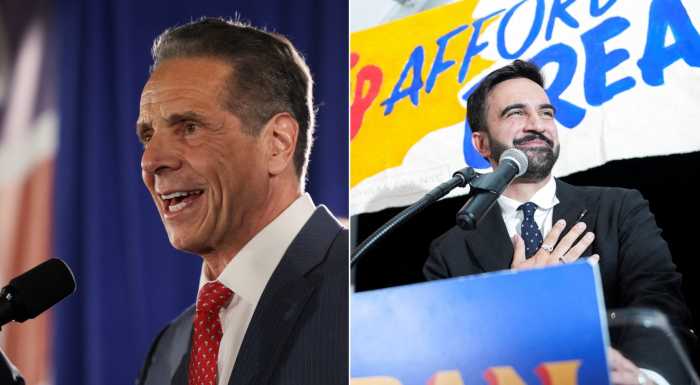By Albert Amateau
The city’s Art Commission on Monday unanimously approved the much-revised renovation plan for the north end of Union Square Park, with some further modifications.
The vote by all eight of the 11 commissioners present at the May 15 meeting means that construction on the Union Square north plaza, the pavilion with a controversial seasonal private restaurant and an expanded playground, can begin this year.
The renovation, sponsored by the Union Square Partnership business improvement district with the Parks Department, has been planned, hotly debated and revised several times over the past several years
Playground space, renovation of the now underused and decrepit pavilion and preserving the north plaza as a place of public assembly and as a venue for the largest Greenmarket in the city have long been points of debate.
Neighbors who have been anticipating the renovation were gratified at the final conclusion. Ken Salzman, who lives a block away from Union Square with his family including three young children, said he hoped the playground would be done before his children were too old to use it. He also lauded the proposed new restrooms, one of which would be accessible only by children and their caregivers.
Gabrielle Tessler, who also lives a block from the square, praised the playground proposal, which includes equipment for older children. Tessler visits Union Square with her daughter, Julia, a 6-year-old pupil at P.S. 41 in the Village.
But several elected officials joined the chorus of neighborhood opponents against a pavilion renovation that depends on use as a restaurant six months of the year.
Nevertheless, the Art Commission commissioners made it clear that they had jurisdiction only on the park design and had no say at all on the use of the pavilion.
The commission approved the plan for the pavilion as submitted by the Department of Parks and the landscape architect Michael Van Valkenburgh Associates, but demanded the elimination of a proposed cantilevered balcony on the south side, which was added to provide the seasonal restaurant with a terrace for 10 additional restaurant seats. Commissioners agreed with several neighborhood critics that the balcony with its 4-foot-high banister was not appropriate for the pavilion.
The commission also eliminated a proposed row of trees next to the north side of the pavilion, saying the trees obscured the view of the pavilion, which was built in 1932. But the commission did endorse the disputed proposal for a row of eight trees along 17th St. at the north end of the open plaza, plus a row of trees on the west side of the plaza between 15th and 17th Sts.
The commission called for the new trees to be planted 30 feet apart in a continuous trench rather than in individual tree pits. The planting arrangement is intended to give the trees a chance to grow in a high-risk location. A row of trees planted in pits along 17th St. in the 1980s to commemorate the Turkish massacre of Armenians in the 1920s did not survive longer than four years.
Jack Taylor, a preservation advocate and public member of Community Board 5, and other critics, have called for a north plaza — the historic site of mass public protests — to be free of any trees or barriers that would inhibit public assembly.
“We urge you to remember that Union Square is a national historic landmark, designated for the role of the north plaza in accommodating mass demonstrations, rallies, parades, political and social protests and the exercise of citizens’ rights of peaceful public assembly and free speech,” Taylor said. “An unhindered and unadorned space has been maintained there since 1882 and even earlier,” he said.
However, William Castro, Manhattan Parks commissioner, told the Art Commission that since the renovation of the south end of Union Square Park was completed four years ago, 98 percent of permits for public assembly at Union Square were issued for the 14th St. end of the park. Nevertheless, he added, the north plaza is still available for public demonstrations.
Castro also pointed out that the new playground will be three times the size of the present playground, and the restaurant space in the renovated pavilion will be smaller than the space that Luna Cafe, the current seasonal outdoor restaurant, occupies on the south side of the pavilion. The plan originally called for a year-round restaurant in the pavilion but was changed last year to seasonal use.
Longtime critics of the plan, including former City Councilmember Carol Greitzer, Paula Schaeffer and Geoffrey Croft, also denounced the proposal for a restaurant in the 31/2-acre park. Castro, however, said that City Councilmembers Christine Quinn and Rosie Mendez, have accepted the plan.
But some critics derided as “public outhouses” the two proposed free-standing restrooms for public use to be built on the east and west sides of the pavilion. Critics said the restrooms within the pavilion should be reconstructed and made public all year-round. Under the approved plan, the pavilion restrooms will be for restaurant patrons during its seasonal operation and open to the public the rest of the year.
Critics including Barry Benepe, a founder of the Greenmarket and the father of Parks Commissioner Adrian Benepe, criticized the location of the playground in the sunken area now occupied by Luna Cafe.
“Nowhere else is there a playground that you have to walk into down a flight of stairs or a ramp,” he observed. Benepe also denounced the restaurant use of the pavilion in an area with many prominent restaurants.
Aides for Borough President Scott Stringer, Assemblymember Richard Gottfried, State Senator Tom Duane and Congressmember Carolyn Maloney called for work to begin as soon as possible on the playground. But they also denounced the pavilion restaurant.
Earlier this year, Community Board 5 approved the plan by a vote of 29 to 1.
































